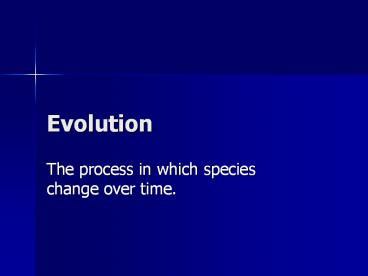Evolution - PowerPoint PPT Presentation
Title:
Evolution
Description:
Evolution The process in which species change over time. Charles Darwin The HMS Beagle Traveling with the ship, Darwin observed many different plants and animals. – PowerPoint PPT presentation
Number of Views:70
Avg rating:3.0/5.0
Title: Evolution
1
Evolution
- The process in which species change over time.
2
Charles Darwin
- Was a British naturalist.
- He was hired to travel on the HMS Beagle to learn
as much as he could about the living things he
saw on the voyage.
3
The HMS Beagle
- Traveling with the ship, Darwin observed many
different plants and animals. - He was very curious about why these living things
were so different from the ones he studied in
England. - This curiosity led to develop The theory of
_______________ by natural selection.
4
The Galapagos Islands
- The Beagle traveled to the Galapagos Islands of
South America. - Here, Darwin made some of his most important
observations!
5
The Galapagos Islands
- Darwin observed that the __________ of the
Galapagos were very different from one island to
the next. - The beaks of the birds varied in shape and size.
6
Darwins Finches
- As Darwin studied his finches, he noticed that
each species was well suited to the life it led. - Insect eaters sharp, needlelike beaks
- Seed eaters strong, wide beaks
7
The Galapagos Islands
- Darwin also noticed that the iguanas that lived
on the island were different from the iguanas on
the mainland. - Island Iguanas had large claws.
- Mainland Iguanas had small claws.
8
The Galapagos Iguanas
- Darwin realized that the claws of the iguana were
also beneficial to the life it led. - The large claws of the island iguanas kept them
from slipping off of the rocks. - The small claws of the mainland iguanas allowed
them to climb trees where they ate leaves.
9
Galapagos Iguanas
10
Life After the Beagle
- ________________ are traits that help organisms
survive and reproduce. - Beak shape and claw length are examples of this.
- When Darwin returned home from life on the
Beagle, he tried to understand how these specific
traits arose.
11
Darwins Conclusion
- Darwin reasoned that arrived on one of the
Galapagos Islands faced conditions that were
different from the mainland. - He came up with the conclusion that species must
gradually change over many generations to become
better adapted to their environment. - This change over time is called _____________.
12
The Theory of Evolution
- What is a scientific theory?
- A well-tested concept that explains a wide range
of observations. - The theory of evolution is what scientists have
determined to be true based on significant
amounts of research, observations, and evidence
to back this up.
13
How does evolution happen?
- Darwin still didnt know one thing how does
evolution happen? - Darwin bred pigeons. He allowed only pigeons with
many tail feathers to mate. This produced pigeons
with two or three times the usual number of
feathers. - This process is called ___________
______________. - Maybe, he thought, something happens like this in
nature!
14
Selective Breeding in Nature
- Why are certain traits selected for (and how) in
nature? - ____________ _____________ is the process by
which individuals that are better adapted to
their environment are more likely to survive and
reproduce than other members of the same species.
15
The Origin of Species
- Charles Darwin, along with biologist Alfred
Russel Wallace, published his explanation in a
book called The Origin of Species.
16
Natural Selection
- Factors that affect the process of natural
selection - Overproduction
- Competition
- Variations
17
Overproduction
- Most species produce far more offspring that can
possibly survive. - Sea turtles lay more than 100 eggs.
- If all of the young turtles survived, the sea
would be full of turtles! - But this is not the case not all of the
offspring will survive.
18
Overproduction
- Sea Turtles are organisms that overproduce
19
Natural Selection
- Factors that affect the process of natural
selection - Overproduction
- Competition
- Variations
20
Competition
- Offspring must compete with each other to
survive. - Offspring compete for resources- food, water,
living space, etc. - Only some will escape from predators.
- Only a few offspring will survive long enough to
reproduce.
21
Competition
- Sea Turtle hatchlings compete for space.
22
Natural Selection
- Factors that affect the process of natural
selection - Overproduction
- Competition
- Variations
23
Variations
- Any difference between individuals in the same
species is called a variation. - We know that this is a result of genetics.
- Some variations make certain individuals better
adapted to their environment.
24
Variations
- Some newly hatched turtles are able to swim
faster than others.
25
Natural Selection
- Individuals that are better adapted to their
environment are more likely to survive and
reproduce. - When these well-adapted individuals reproduce,
their offspring inherit the alleles for these
adaptations. - Thus
26
Natural Selection
- The environment has selected these well-adapted
organisms to be the parents of the next
generation. - Nature has selected natural selection
- Over a long period of time, natural selection can
lead to evolution (the changing of a species). - Helpful variations gradually accumulate in a
species, while unfavorable ones disappear.
27
(No Transcript)































